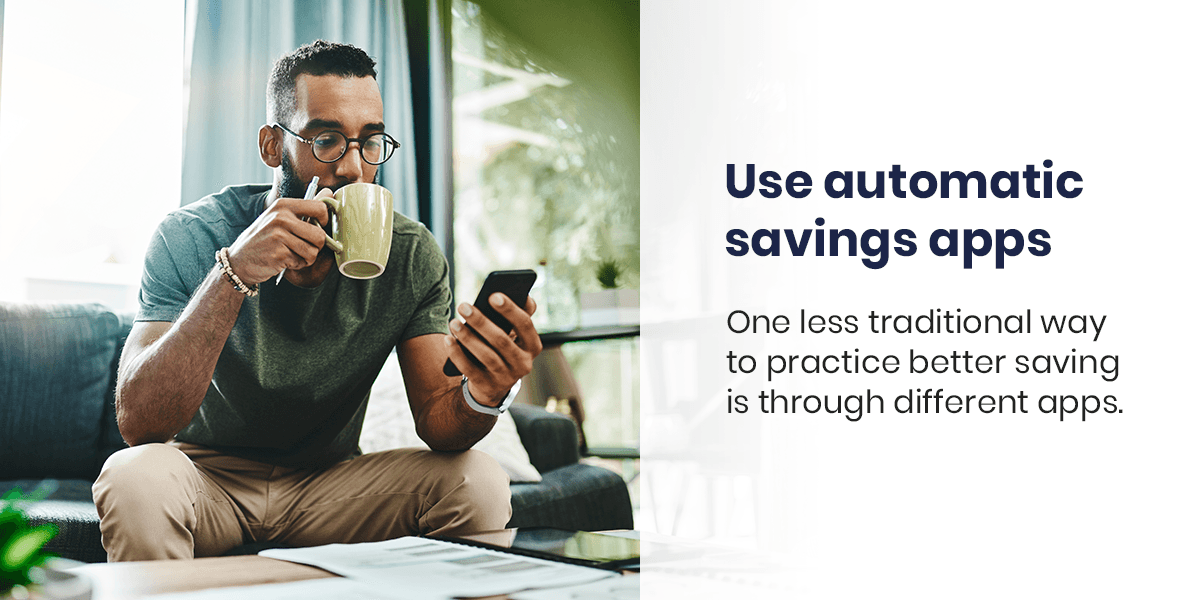
Saving money can seem like a challenging feat, especially when it feels like prices for everyday necessities are constantly on the rise. Despite the increasing cost of living, there are many tricks, some classic and some more modern, to help ease the burden of common expenses.
It is possible to save money without making any drastic changes to your lifestyle. Budgeting efficiently and allocating funds correctly can save you money without you even thinking about it. Once you practice simple ways to save, they will become just another part of your everyday routine.
If you follow these nine easy steps, you’ll notice an increase in your savings in no time!

1. Save your change.
Using cash is a good start on your venture to save money. When you use cash, you physically have the bills and change in your hand, so you can realistically see what you spend and where you spend it.
If you already use cash, save your change. Change really does add up over time, so be conscious of what you do with any coins you find or have lying around.
One way to keep track of and save your change is to start a coin jar. Exactly as it sounds, set aside a specific container to place all of your coins in that you accumulate throughout the day.
It is so easy after using cash to just toss your change in your purse or wallet and forget that you have those extra coins. Instead, assign a certain pocket to put your change into until you get home. Once home, throw your change in your coin jar. If you let those coins pile up, it will surprise you how much money you used to let just sit around in cup holders and coat pockets.

2. Use automatic savings apps.
One less traditional way to practice better saving is through different apps. There are so many lifestyle and financial apps floating around out there, so there surely is one that is right for you. Here are just a few of your options when trying out a savings app:
Chime
Chime is a free mobile banking app with an automatic savings program. Its main perk is its Save When You Spend feature, where it “automatically rounds up transactions to the nearest dollar and transfers the Round Up from your Spending Account into your Automatic Savings Account app.”
For example, if your total bill is $4.75, Chime puts the extra $.25 into your savings. This means that with every purchase, the app will transfer some money to your savings account without you even realizing it.
Digit
Digit is a personalized money and investment app that helps you save money where you can afford to do so. This app uses an algorithm to track your income and expenses so that it automatically puts money you can spare in a savings account. It is easy to use and allows you to move your money back in your checking account if you need to with no penalties.
This app claims to help you “manage your money, improve your financial health, and save an average of $2,500 a year along the way,” according to members' average savings in 2020.
Signing up for a Digit account is free for the first 30 days. After this, though, it is a monthly charge of $5 to keep your account.
Acorns
Acorns is a savings and investment app geared toward beginner investors. Similar to Chime, Acorns has a robo-advisor feature that rounds your purchase to the nearest dollar and puts the remaining change into a separate account. The app offers different pre-designed robo products, such as Invest, Later, Spend, Found Money, and Early.
While Acorns can help save you money, the app focuses more on investing. When you sign up, Acorns will ask you a variety of questions to create your profile, which personalizes your investment plan.
This app has three different bundled plan options. Lite, geared toward new investors, costs $1 per month and only offers Invest, its investment account. For a rate of $3 each month, you can get the Personal plan, which offers Invest, the retirement account called Later and the Banking, or checking, account. The last option costs $5 per month and is called Family. This plan includes each previous account plus their Early account, which is an investment account for kids.
B of A Keep the Change
Bank of America’s Keep the Change program, like Chime and Acorns, rounds each purchase to the dollar and transfers anything extra from your checking account into your savings. The one significant difference between the Bank of America program and some of the other apps listed is that you need to have a Bank of America checking and savings account to enroll.
3. Put your money into a savings account with a high-yield interest.
A lot of savings accounts offer interest rates just for keeping your money with them. It’s important to look at different options to see which savings account will give you the best Annual Percentage Yield (APY), or the rate of return on savings deposits.
Average savings accounts pay around 0.06 percent APY, while high-yield savings accounts, mostly used for emergency funds or savings storage, typically pay 20 to 25 times the national average savings rates. Some examples of high-yield interest accounts are:
Ally
Ally.com is a significant starting point for looking at High Yield Certificate of Deposits (CDs). A CD, however, differs from a savings account in that moving your money around is less flexible. If this is not a big deal to you, then it is worth it to check Ally out.
Their website features a calculator that allows you to see the estimated earnings of your CD by entering your opening deposit amount and the term of the CD. This is a great way to plan out your possible earnings without you having to worry about touching your money.
Vio Bank
Vio Bank offers online savings accounts with a 0.51% APY. Their website lists some of their savings account perks as having a $100 minimum deposit to open an account, no monthly fees, insurance up to $250,000 and six free withdrawals per monthly cycle.
Popular Direct
Popular Direct has many options for high-yield CDs and savings accounts. Their product selector tool allows you to express your savings goals, and they match you with the best products for needs.
Savings accounts at Popular Direct offer up to 0.45% APY and are FDIC insured. One drawback of this account, however, is that the minimum deposit to open your account is $5,000. Their CDs offer an APY of as high as 0.85% with a minimum balance of $10,000.

4. Create lists before going shopping.
Whether it is for groceries, clothes or any other purchases, make a list before you go shopping and stick to only buying things you put on that list. This way, you only buy the things you truly need. People spend so much extra money by browsing the aisles when they go to the store without a set goal in mind.
A few other things that go hand-in-hand with sticking to your list are buying only what you need, using what you have before buying new and trying to avoid browsing stores online because this will only tempt you to purchase items you don’t need or might not use.
5. Put the money you saved from discounts into your savings account.
You “save” money from getting discounts and using coupons, but are you really saving that money? Instead of using discounts as an excuse to buy something else to make up for the saved amount, calculate the difference between the original price and the price you pay and put the difference into your savings account. If you do this, your discounts actually will add up in a way that you can see.
6. Save your extra income.
If you get a bonus or a raise at work, pretend that you didn’t. Put any bonus money or the difference between your old and new paychecks into your savings. Once again, this will make a difference that you can see. This is especially important around the holidays and any bonuses you may get during that time. As tempting as it may be to spend this money, it will be much more gratifying to see the build-up in your savings account.
7. Use cash instead of a credit card.
Shopping with cash makes it a lot easier to monitor what you spend. When you swipe a card, you do not realize how much money you spend. If you have the physical bills in hand, however, you can see exactly what you hand to the cashier.
Cash also allows you to limit yourself. For example, if you only grab a ten dollar bill, you only have ten dollars to spend and nothing more. If you take your credit card and tell yourself you are only going to spend ten dollars, you still can go over that amount if tempted.
In fact, studies show that people will spend up to 83% more when they pay with a credit card over cash.
8. Hang out with friends at home.
You don’t need to go out to have a good time. Sometimes having friends over is just as much fun as if you were to go out somewhere. Spending money on activities and food is not a necessity, and if your budget cannot handle it, there is no shame in having a night in. Invite some friends over, have a movie night or whip out some old board games. You can have just as many laughs with games and things you already own rather than going out and spending money on something new or different all the time. On the same note, make coffee at home instead of stopping to buy it from a coffee shop. With a little bit of a change in your routine, this will help you save up to $5 a day if you constantly stop for coffee on your way out.
9. Your work can help.
Most companies offer different ways to help you organize your funds. Research the options your company offers and decide what is best for your needs. Discuss putting money into a retirement account. Many companies will match up to a certain percentage of your retirement investment. Also, request that they deposit a certain percentage of your paycheck directly into your savings account. This way, if the money goes directly into your savings instead of your checking, you will not have to move the funds yourself. This means that you do not even see the money and likely won’t even think about spending it.

Explore Your Options
Overall, there are a lot of different ways you can save money without even realizing it. No matter what lifestyle you currently have, there are ways to build your savings without making any drastic changes.
While these are all simple and effective ways to save, not all of these options may be for you. Everyone has different values and a different lifestyle, and you should not have to change those to save money. Instead, plan out what is important to you. Decide which of these tips will least affect your life and will not interrupt your routines, and you will save money without having to think about it.
Find which of these tips or which combination of saving techniques works best for you and stick to them. If you follow these tips consistently, you will see great results when you check your savings accounts.


